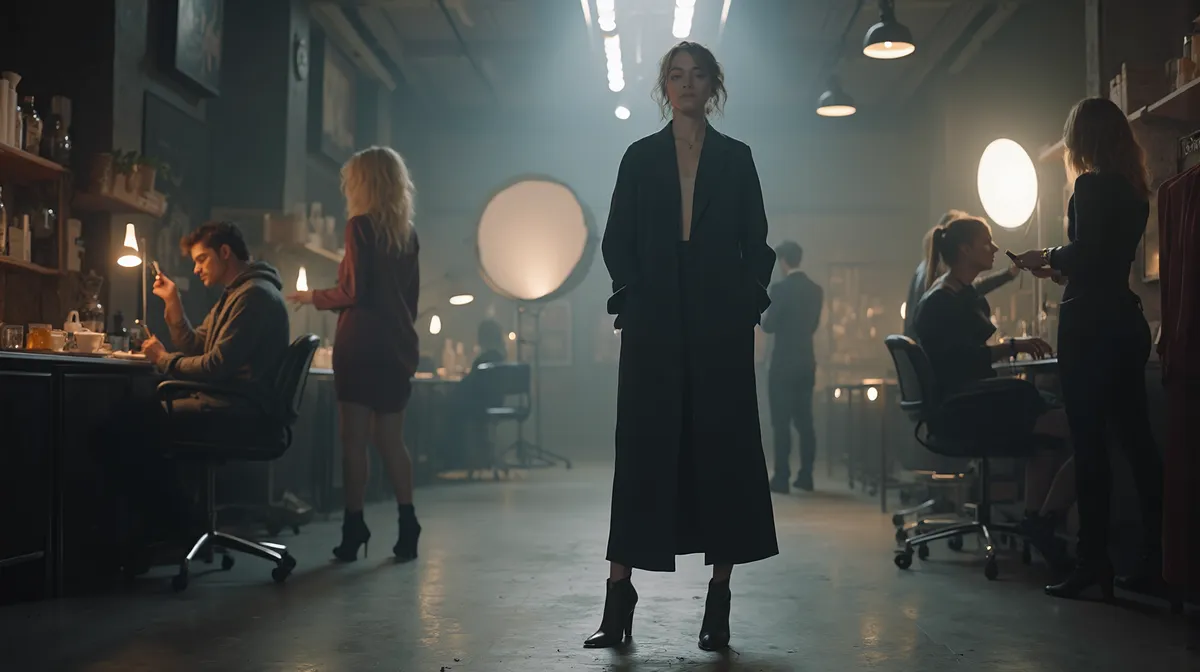

Modeling Agency vs Modeling Platform: Understanding the Essential Differences in the Fashion Industry
mode - None
The world of modeling fascinates and attracts many people who want to make a career in this prestigious field. The distinction between a traditional modeling agency and a matching platform is a fundamental aspect to grasp for anyone who wants to navigate this demanding industry. These two entities, although serving as intermediaries between models and clients, operate according to radically different principles and offer distinct services.
The modeling sector has undergone significant changes in recent years, particularly with the advent of digital technology, which has transformed recruitment and matching methods. According to a recent study, over 65% of new models discovered in 2024 first established their online presence through platforms before signing with traditional agencies.
This article explores the specific characteristics of each model, their respective advantages, and helps you determine which option might best suit your professional ambitions in the fashion industry.
What is a Traditional Modeling Agency?
Traditional modeling agencies represent established institutions in the fashion industry. They operate as specialized businesses that manage the careers of the models they represent. Their role extends far beyond simple matching.
These professional structures act as qualified intermediaries between professional models and potential clients such as fashion brands, photographers, magazines, and event organizers. Their expertise is manifested through several essential aspects of career management.
One of the main characteristics of traditional agencies lies in their rigorous selection process. They actively search for, identify, and recruit potential talents according to specific criteria established by the agency and adapted to market demands. This meticulous selection ensures a certain level of quality and professionalism for clients.
The Recruitment and Training Process
Recruitment in a modeling agency typically follows a well-defined path. Agency scouts identify potential talents in various contexts - on social media, in the street, at specific events, or through spontaneous applications. This active search constitutes the first step in a selective process.
Once identified, promising candidates undergo an in-depth evaluation. The agency examines not only their physical appearance but also their commercial potential, personality, and ability to adapt to the demands of the profession. Statistics indicate that less than 5% of individuals approached by agencies ultimately sign a professional contract.
Training represents another crucial aspect offered by traditional agencies. Unlike platforms, they invest in the development of their models' skills through posing workshops, catwalk training, nutrition counseling, and physical maintenance. This comprehensive preparation aims to transform raw talent into a professional model capable of meeting the diverse expectations of the industry.
Representation and Career Management
Representation is at the heart of the service offered by traditional agencies. They actively negotiate contracts, rates, and working conditions for their models. This protective function is particularly valuable for beginners who do not yet master the subtleties of contractual agreements in the sector.
Established modeling agencies generally have an extensive network of contacts in the industry, built over many years of collaboration with prestigious fashion brands, renowned photographers, and influential art directors. This relational capital represents a significant asset for their models, who benefit from exclusive opportunities.
Financial management is also part of the services provided. The agency handles billing, payment tracking, and sometimes even tax management for their models. In exchange for these comprehensive services, the agency takes a commission, typically ranging from 20% to 40%, depending on the agency's prestige and the type of contract. According to a sector study, the average earnings of models in agencies vary significantly, ranging from €30,000 to several million euros per year for the most famous.
Types of Modeling Agencies
The modeling industry is characterized by a diversity of agencies with distinct positioning. This variety allows models to find a structure adapted to their profile and professional aspirations.
Fashion/luxury agencies represent the elite of the sector. Prestigious names like Elite, Ford, or IMG impose extremely strict selection criteria and elitist standards. These agencies work primarily with high-end fashion houses, top-tier fashion magazines, and international advertising campaigns. Their models regularly participate in the most prestigious fashion weeks and appear in influential editorial content.

Financial Aspects and Remuneration
The economic model of the two systems directly influences the remuneration of models. Modeling agencies operate on a commission-based principle, typically taking between 20% and 40% of each contract obtained by their models. This commission rewards the agency for the services provided.
Despite this deduction, models in agencies often benefit from higher earnings due to the agency's negotiating power and access to prestigious contracts. A recent study reveals that models represented by agencies earn an average of 70% more per contract than their independent counterparts, even after deducting the commission.
Platforms, on the other hand, allow models to retain their entire earnings. Their economic model relies primarily on premium subscriptions offered to models and fees charged to clients for access to the database. This absence of commission represents an immediate financial advantage, particularly appealing to beginners or occasional models.
Career Development and Opportunities
The professional trajectory differs significantly depending on the chosen option. Traditional agencies build careers over the long term, with a targeted development strategy. They guide their models towards carefully selected opportunities that enhance their image and gradually increase their market value.
This strategic approach explains why 85% of models featured on the covers of major fashion magazines are represented by established agencies. The professional network of an agency opens doors that are generally inaccessible to independents, particularly for fashion weeks and international fashion events.
Platforms offer a more democratic but less structured approach to career development. They provide a multitude of varied opportunities without prior quality filtering. This diversity allows models to quickly gain experience in different areas, but without the strategic coherence provided by an agency.
"The fundamental difference lies in the long-term vision. An agency invests in its models as assets whose value should increase over time, while a platform facilitates punctual transactions without necessarily considering the model's overall trajectory", analyzes a consultant specializing in the fashion industry.
Selection Criteria: Which Option Suits You?
Choosing between a traditional agency and a matching platform requires in-depth personal reflection. Several determining factors should guide this decision, crucial for your future in modeling.
Your professional objectives are the first element to consider. If you aspire to an international career in high fashion, to walk the runway for top fashion houses, or to appear in prestigious magazines, the traditional agency route generally imposes itself. Statistics show that 95% of models participating in fashion weeks in Paris, Milan, London, and New York are represented by established agencies.
On the other hand, if you view modeling as a complementary activity, if you seek maximum flexibility, or if you want to explore various facets of the profession without constraint, platforms offer an interesting alternative. They are particularly suited to individuals who do not meet the physical standards of traditional agencies but still want to find their place in the industry.
Personal Profile and Physical Characteristics
Physical characteristics play a determining role in access to traditional agencies. These agencies generally seek profiles corresponding to current industry standards: minimum height of 175cm for women and 185cm for men in high fashion, slender silhouette, and specific proportions.
However, physical criteria vary depending on the type of agency. Commercial agencies show more flexibility and seek expressive faces and personalities rather than perfect measurements. According to a recent survey, 72% of commercial agency directors consider personality and charisma as important factors as physical appearance.
Platforms, by their inclusive nature, welcome all profiles without discrimination. This openness has enabled the emergence of new segments in the industry, such as plus-size models, seniors, or atypical models. This diversification responds to a growing demand from brands for more authentic and inclusive representations in their communications.
Level of Experience and Availability
Your current experience in modeling also influences the most suitable choice. Newcomers without a professional portfolio encounter difficulties in directly integrating a prestigious agency. Statistics indicate that less than 5% of new models sign with a major agency without prior experience.
In this context, platforms can constitute an excellent entry point into the industry. They allow models to progressively build a book, gain experience in front of the camera, and understand the sector's mechanisms. Many models today represented by agencies started their journey on platforms before being discovered.
Availability is another crucial factor. Agencies generally require a significant commitment from their models, particularly during intense periods like fashion weeks or shooting seasons. This requirement can be incompatible with studies or another primary professional activity.
Platforms offer greater flexibility, allowing models to choose projects that correspond to their availability. This flexibility is particularly suited to fashion professionals who want to exercise modeling as a complementary activity.
Geographical Location and Mobility
Geographical location significantly influences the opportunities available. Major agencies concentrate their activities in fashion capitals like Paris, Milan, New York, or London. Being based in one of these strategic cities greatly facilitates access to castings and prestigious opportunities.
International agencies often require significant mobility from their models, with frequent travel between different markets. This availability for travel constitutes a non-negotiable prerequisite for an international career. Industry data reveal that top models spend an average of 200 days per year traveling for professional purposes.
Platforms, thanks to their digital nature, partially transcend these geographical constraints. They offer the possibility of finding local opportunities even outside of major fashion centers. This accessibility represents a significant advantage for models based in less central regions.
"Geography remains a determining factor in the modeling industry. Even in the digital age, nothing replaces physical presence in fashion capitals to build an international career", confirms an agent with over twenty years of experience.
The Evolution of the Sector and Current Trends
The modeling industry is currently undergoing a profound transformation. Several major trends are redefining the relationships between models, agencies, and clients, creating a more complex and diversified ecosystem.
Digitalization constitutes the primary driver of this evolution. Social media have disrupted traditional mechanisms of model discovery and promotion. Instagram has become an indispensable tool, used by 97% of casting directors to identify new talents. This reality has forced traditional agencies to integrate these new channels into their recruitment and promotion strategies.
The emergence of model-influencers represents another significant mutation. These hybrid profiles combine traditional modeling work with content creation on social media. Their value is now measured by their digital audience as much as their traditional photogenic qualities. This trend has given birth to new forms of collaboration between brands and models, blurring the boundaries between advertising, editorial content, and personal sharing.
Hybridization of Models and New Approaches
In response to these evolutions, a progressive hybridization of intermediation models is observed in the industry. Traditional agencies are developing their own digital platforms to facilitate direct matching between their models and certain clients, while maintaining their supervisory and advisory role.
Meanwhile, some platforms are enriching their service offerings to approach the agency model. They now provide personalized coaching, online training, and even tax management services. This convergence of models is redefining the boundaries between traditional agencies and platforms, creating new opportunities for models and clients alike.